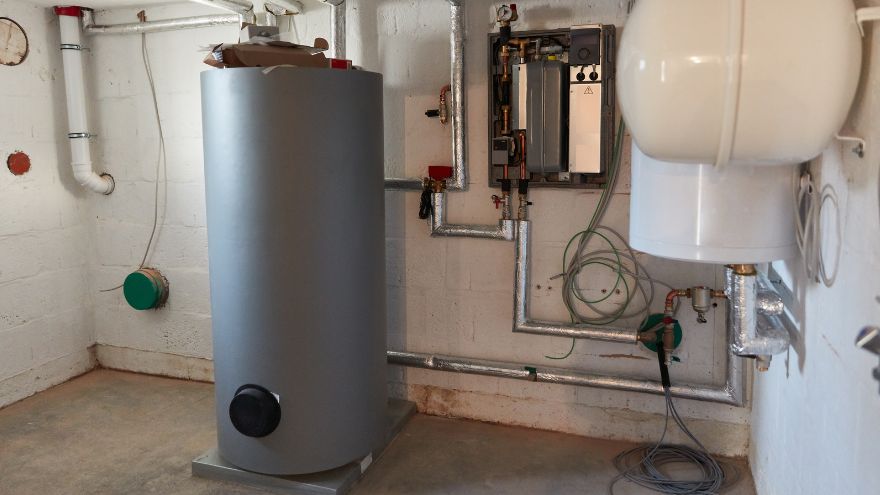Heating a single-family house is currently quite a challenge. On the one hand, appropriate conditions enabling the optimal use of heat sources, on the other hand, ecological requirements currently faced by house builders must be taken into account.

Heat buffer and its importance
Low operating comfort and maintenance-free operation are some of the most frequently mentioned aspects taken into account by those planning construction. In fact, at the design selection stage, you should seriously consider all aspects, including the heating option.
When planning to heat your home, it is worth finding out what a heat buffer is and considering the benefits and possibilities of its use. In terms of structure, the buffer is a tank with a specific capacity. Its task is to collect excess thermal energy, which can be used when the demand for heat increases.
The mechanism of operation of the entire system is related to the storage of surplus heat that was generated by the heating boiler and was not used by the elements of the heating system, such as radiators or underfloor heating. Buffers work great in the transitional period, protecting the heating installation against frequent switching on and off, thus reducing the risk of damage to the control mechanism.
Check the buffers at the Onninen wholesaler
How long does it take for a 1000 liter buffer to heat up?
 The heating time of a 1000 l buffer is one of the parameters provided by the manufacturers of individual models. It is worth noting that the rate may also be influenced by external factors, e.g. the place where it is installed (unheated garage, boiler room, etc.), the material it is made of, whether it has been additionally insulated, and the type of heating installation, house area or boiler power.
The heating time of a 1000 l buffer is one of the parameters provided by the manufacturers of individual models. It is worth noting that the rate may also be influenced by external factors, e.g. the place where it is installed (unheated garage, boiler room, etc.), the material it is made of, whether it has been additionally insulated, and the type of heating installation, house area or boiler power.
When looking for a suitable variant, make sure that the buffer is charged no more than once every 24 hours during the heating season (i.e. winter). When determining the tank heating time, an algorithm is used in which kW is multiplied by 24 hours, which shows the maximum daily consumption in a given building. The amount of energy that can be stored is then determined. How much time the buffer used needs to heat up depends largely on the heating model used. The optimal solution will be underfloor heating, which needs a relatively low temperature to effectively heat the building.
Which heat buffer for a 120 m2 house?
Choosing the right tank is a key issue and the purchase should be treated as a long-term investment. A buffer of a good brand, adapted to the needs of a given building, allows:
- extend the life of the heating device, both the heat pump and the gas boiler,
- reduce costs incurred for heating the building,
- increase the efficiency of the use of collected energy, e.g. in buildings using solar collectors.
Heat buffers are very practical and cost-saving elements of the heating system, so when deciding to install them, you should pay attention not only to the price, but mainly to the quality of workmanship and the size adapted to the needs of a specific project and building. Both buffers and all available accessories in the wholesaler offer a wide range of products that allow you to find all the necessary elements in one place.
The most important criterion is the size, i.e. capacity of the tank. In theory, the larger the better, because the more heat it can store, which in practice means that the installation's boiler will turn on less often, which has a direct impact on its lifespan. Manufacturers offer various variants, with capacities ranging from just 300 to as much as 10,000 liters, but tanks larger than 2,000 liters are usually not used in single-family houses. A specific variant is selected taking into account the heating needs of a given building and the power of the heating boiler.
Which boiler for a 1000 l buffer (how many kW)?
When selecting a boiler for a buffer, you should follow the rule that 1 kW of thermal energy from your heating boiler requires 50 liters of water. According to this principle, a buffer tank with a capacity of 1,000 l to 1,200 l requires the use of a boiler whose power to heat the entire house is at least 21 kW. Depending on the energy standards used, a buffer with a capacity of 1,000 liters and a heating boiler with a power of 21 kW may be sufficient to effectively heat a house with an area of up to 200 m2, assuming that the buffer is used only by the heating system.
When installing a heating installation with a buffer, the best solution is to use the help of specialists who will help you properly match the solution, taking into account, among others: thermal insulation of the building. Knowing exactly what the demand is, you can match the appropriate elements, e.g. boilers and furnaces . The heating system to be used in the building is also an important issue, because buffer tanks for heat pumps are selected differently from those for central heating using a central heating furnace.
